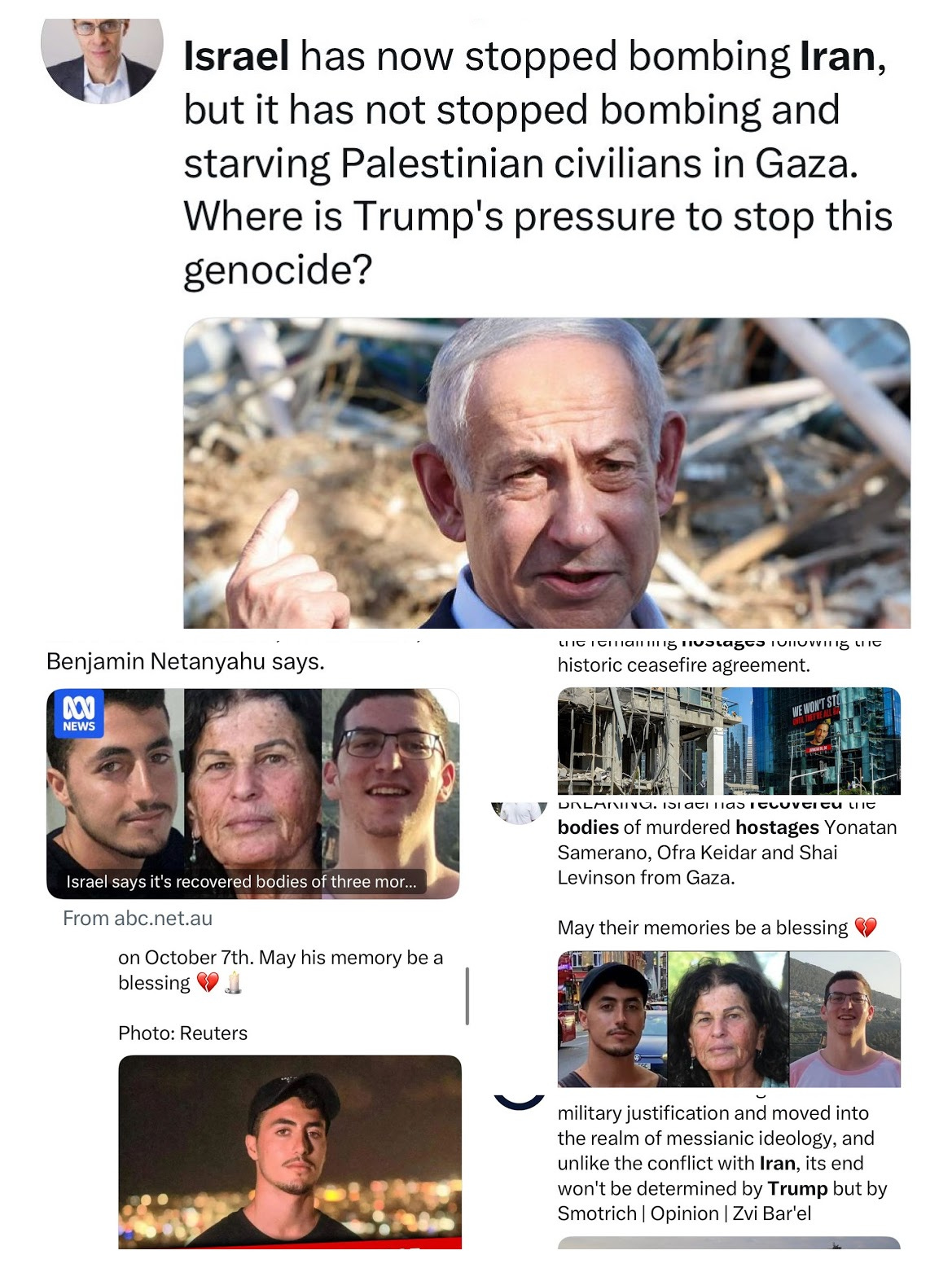Israel at War - Day 629 of Gaza War
1. Trump Ordered an End to the War Between Israel and Iran
In a tweet to his Truth social media platform, Trump announced the end of the war between Israel and Iran. The war lasted 12 days. Shortly after the announcement- Iran sent a ballistic missile that caused damage in Israel. Israel decided to retaliate despite the ceasefire that was allready in effect. But once President Trump found out about it, he was furious. When taking to journalists he rebuked Iran, but mainly Israel for the violation of the ceasefire. Trump called PM Netanyahu and ordered him to bring back the jet fighter planes that were already on their way to Iran for another strike. PM Netanyahu had to order 50 attack planes to make a u-turn minutes before the strike. This was a powerful move by President Trump, in terms of constraining Israel’s ability to conduct its’ own policy.
Later CNN and the New York Times reported, based on classified American sources, that unlike the estimation of President Trump, the American strike on three nuclear sites did not cause significant damage to the facilities. These reports enraged President Trump. He not only called CNN and NYT liars, he also presented an excerpt from a report by the Israel Atomic Energy Commission. The Israeli commission claimed that the there was indeed significant damage to the facilities. But President Trump neglected to include the bottom line of the report, which indicated that if Iran would be able to put its’ hands on nuclear material, than it will be able to recover and restore its’ nuclear capabilities shortly.
All experts - Israelis and Americans - say that it is too soon to know if Irans nuclear refining capabilities were neutralized by the massive airstrike, or whether it can soon recover and continue with their plans.
Meanwhile the US is trying to return to the negotiations table with Iran and reach an agreement. Special envoy Steve Witkoff will be in charge of the talks.
It is important to add here, that President Trump called on Israel to immediately cancel PM Netanyahu’s trial. In an angry tweet to his social media platform, Truth, President Trump called the bribery indictment against PM Netanyahu a witch hunt, saying he is being chased, and the trial should be canceled, because it was tailored. President Trump promised to save PM Netanyahu from the trial.
2.Iranian Missile Attacks Caused Extensive Damage and Enacted a High Price in Human Lives
Twenty eight Israelis died in Iranian missile attacks on Israel and hundreds were injured. Iran tried and many times managed to damage strategic sites in Israel. The Iranian ballistic missiles are heavy, carrying hundreds of kilograms of explosives. Some of the missiles fell in civilian residential neighborhoods causing extensive damage and taking a high toll in human lives. A neighborhood in northern Tel Aviv was dramatically damaged by an Iranian missile. A home for the elderly was damaged, and many townhouses in the area were completely demolished. The neighbourhood is close to Tel Aviv University. Another missile extensively damaged a neighborhood in the southern town Be’er Sheva. Four people died while in a protected safe room. This was the result of a direct hit, and not even the safe room could protect them. One of the people who died there was, Neomi Shannan, an activist for returning the hostages from Gaza. She was the central leader for the hostages families in Be’er Sheva. She used to demonstrate daily and was photographed only one day prior to the attack holding a sign for the release of the hostages.
More than 5,000 people were evacuated from their homes, due to extensive damage rendering their homes dangerous and uninhabitable. They were evacuated to hotels all over the country. Tens of thousands of houses were totally destroyed, or partly damaged, many of those are no longer inhabitable, and it will take a lot of time and money to rebuild them, especially as Israel is currently suffering a severe shortage of construction workers..
It is important to say that the military campaign with Iran was very expensive with some analysts estimating the cost of the damage alone at more than 300 billion NIS (around $900 million).
3. U.S. Air Strike on Iran’s Nuclear Enrichment Facilities
Earlier this week, U.S. forces carried out an attack on several nuclear enrichment facilities in Iran, including Fordow, Natanz, and Isfahan. The orchestrated attack, named Operation Midnight Hammer, included several tactics, such as diversion, stealth, and pre-assault disruption tactics. The U.S. deployed a fleet of seven B‑2 Spirit stealth bombers on an 18‑hour mission, supported by F‑22 Raptors, F‑35 Stealth Jets, submarine cruise missiles, aerial refueling tankers, and reconnaissance aircraft
To secure surprise, a decoy squadron of B‑2s flew west over the Pacific—some tracked by OSINT communities and reportedly diverted through Guam—to mislead Iranian radar and open‑source analysts. Pentagon officials confirmed this was a deliberate deception maneuver: “deception tactics, including decoys,” were used alongside escort fighters sweeping airspace prior to the strike
The operation was carried out in coordination with Israel. Several days before the U.S. attack, Israel launched a targeted campaign—a combination of covert Mossad drone assaults and IAF airstrikes—specifically designed to neutralize Iran’s air defenses, disable radar detection capabilities, disable surface-to-air missile systems, and neutralize missile launchers within Iran.
No civilians were reported dead or injured in the attack. Iranian sources reported that all nuclear facilities personnel were evacuated prior to the attack.
4. Exceptional Attacks on Journalists in Israel
The war in Iran resulted in a lot of hostility towards the foreign press based in Israel, due to fear of violation of military censorship.
For background: Israel is the only western democracy in the world that still imposes military censorship on journalists and publications. Every journalist working in Israel, Israeli or foreign, working for local media outlet or other foreign ones, are all subject to military censorship. In daily practice this may be a minor bother for most journalists. There is aLeah’s a representative of the military censor in every newsroom of every tv channel in the country. According to the law every item, story or report that concerns military or state security, has to be cleared by the censor prior to publication. During time of war this becomes much more intrusive.
In the middle of the war with Iran, the censor issued specific restrictive guidelines, especially regarding the exact location that an Iranian missile hit and damaged. That restriction was intended to prevent the Iranians from being more precise when targeting key strategic facilities in Israel. Therefore the censor forbade anyone from mentioning the exact location of a missile hit. In addition, there is an executive order that forbid Al Jazeera from operating in Israel, due to intensive anti Israel incitement in the Qatari network. Unfortunately many individuals took that censorship order further and decided to accost, interfere with, and attack every journalist, Israeli or foreigner, and every foreign and Israeli network during live broadcasts. In addition, policemen arbitrarily decided also to impose military censorship and detained journalists, mainly camera persons in the middle of their work, many times with no real reason, and no understanding of the situation while accusing them of working for Al Jazeera. More than 350 journalists came to Israel during the military campaign with Iran. These attacks were subject to hearings at the Knesset (the parliament) and court petitions.
5. In the Shadow of the Iran War, the Gaza War Continues
Earlier this week, the IDF recovered the bodies of three hostages from Gaza: Ofra Keidar (70), Yonatan Samerano (21), and Staff Sgt. Shay Levinson (19). They were brought to burial more than 620 days after they were killed and their bodies abducted to Gaza during the Hamas October 7, 2023, attacks. The Hostages Families Forum continues to call for renewed efforts to secure the release of the remaining 50 hostages.
Also, this week, seven Israeli soldiers aged 19 – 21 were killed in Khan Younis in southern Gaza, when their armored engineering vehicle was attacked with a side bomb placed by Hamas operatives. The vehicle erupted in flames and all rescue attempts failed. This brings the total IDF death toll since October 7th, 2023, to approximately 879.
According to an article published this week in a major Israeli news outlet, nearly two million Gazans are now concentrated in only 18% of the Gaza strip, which has resulted in drastic humanitarian conditions, including the eruption of infectious diseases, lack of privacy and increased emotional distress affecting all civilians and particularly women and girls.
According to the Hamas controlled health ministry and various media sources, more than 150 Palestinians were killed this week in the Gaza strip by IDF airstrikes and near aid distribution sites. In an Ha’aertz expose, IDF soldiers testified that they were given orderd to shoot at unarmed civilians approaching aid distribution sites, even when they did not represent a threat.
On thursday evening, thousands of Israelis took to the streets of Tel Aviv calling for a comprehensive hostage deal and an end to the war in Gaza.









